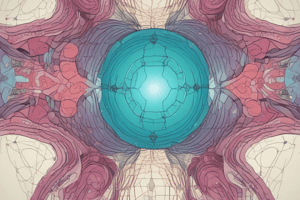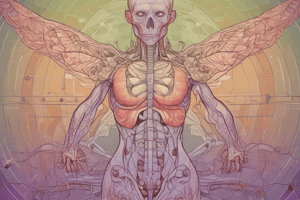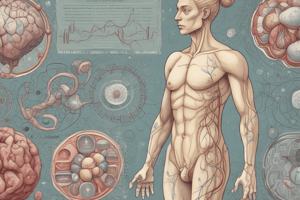Podcast
Questions and Answers
Which hormone stimulates the release of growth hormone (GH)?
Which hormone stimulates the release of growth hormone (GH)?
- Somatostatin
- Growth hormone-releasing hormone (GHRH) (correct)
- Thyrotropin-releasing hormone (TRH)
- Corticotropin-releasing hormone (CRH)
Which hormone is responsible for stimulating the release of cortisol?
Which hormone is responsible for stimulating the release of cortisol?
- Growth hormone-releasing hormone (GHRH)
- Corticotropin-releasing hormone (CRH) (correct)
- Somatostatin
- Thyrotropin-releasing hormone (TRH)
Which of these hormones is NOT produced by the anterior pituitary gland?
Which of these hormones is NOT produced by the anterior pituitary gland?
- Thyroid-stimulating hormone (TSH)
- Growth hormone (GH)
- Adrenocorticotropin (ACTH)
- Dopamine (correct)
What is the effect of somatostatin on growth hormone production?
What is the effect of somatostatin on growth hormone production?
What is the target organ for the pulsatile stimulation of gonadotropin-releasing hormone (GnRH)?
What is the target organ for the pulsatile stimulation of gonadotropin-releasing hormone (GnRH)?
Which of the following hormones is not directly involved in the regulation of diuresis, or the process of urine production?
Which of the following hormones is not directly involved in the regulation of diuresis, or the process of urine production?
What is the primary effect of vasopressin on the body?
What is the primary effect of vasopressin on the body?
What is the target organ for thyroid-stimulating hormone (TSH)?
What is the target organ for thyroid-stimulating hormone (TSH)?
What is the primary role of hypothalamic hormones in the endocrine system?
What is the primary role of hypothalamic hormones in the endocrine system?
Which class of drugs is used to stimulate growth hormone signaling?
Which class of drugs is used to stimulate growth hormone signaling?
Which of the following is NOT a characteristic of growth hormone signaling inhibitors?
Which of the following is NOT a characteristic of growth hormone signaling inhibitors?
What is one indication for using drugs that regulate water homeostasis?
What is one indication for using drugs that regulate water homeostasis?
What do analogs and super-agonists of gonadotropin do in the context of hormone therapy?
What do analogs and super-agonists of gonadotropin do in the context of hormone therapy?
Which mechanism of action is commonly associated with drugs that stimulate gonadotropin regulation?
Which mechanism of action is commonly associated with drugs that stimulate gonadotropin regulation?
What adverse effect might be associated with the use of growth hormone inhibitors?
What adverse effect might be associated with the use of growth hormone inhibitors?
Which of the following statements about posterior pituitary hormones is correct?
Which of the following statements about posterior pituitary hormones is correct?
What is the primary function of circulating hormones?
What is the primary function of circulating hormones?
Which of the following is NOT an application of drugs that act on the hypothalamic-pituitary axis?
Which of the following is NOT an application of drugs that act on the hypothalamic-pituitary axis?
Growth hormone (GH) and prolactin (PRL) are classified as which type of hormone?
Growth hormone (GH) and prolactin (PRL) are classified as which type of hormone?
Which hormone receptor mechanism is associated with hormones that exert rapid effects through signal transduction pathways?
Which hormone receptor mechanism is associated with hormones that exert rapid effects through signal transduction pathways?
What role do hormonal agonists play in pharmacological treatments?
What role do hormonal agonists play in pharmacological treatments?
Which test is used for identifying central or peripheral adrenal insufficiency?
Which test is used for identifying central or peripheral adrenal insufficiency?
What characterizes the classification of hormones based on their structure?
What characterizes the classification of hormones based on their structure?
Which hormone is known for acting via GPCR (G protein-coupled receptors)?
Which hormone is known for acting via GPCR (G protein-coupled receptors)?
What is the primary physiological role of vasopressin in the body?
What is the primary physiological role of vasopressin in the body?
Which administration routes are effective for Desmopressin (DDAVP)?
Which administration routes are effective for Desmopressin (DDAVP)?
What condition can result from a deficiency in vasopressin?
What condition can result from a deficiency in vasopressin?
Which peptide hormone of the anterior pituitary is essential for growth regulation?
Which peptide hormone of the anterior pituitary is essential for growth regulation?
What is a side effect associated with Desmopressin administration?
What is a side effect associated with Desmopressin administration?
Which drug acts as an antagonist at V1a and V2 receptors?
Which drug acts as an antagonist at V1a and V2 receptors?
What is the mechanism of action (MOA) of Tolvaptan?
What is the mechanism of action (MOA) of Tolvaptan?
What is the main pharmacokinetic characteristic of Desmopressin?
What is the main pharmacokinetic characteristic of Desmopressin?
Which of the following statements accurately describes the effects of continuous administration of a GnRH superagonist?
Which of the following statements accurately describes the effects of continuous administration of a GnRH superagonist?
Which of the following medications is a GnRH antagonist?
Which of the following medications is a GnRH antagonist?
What is the mechanism of action of GnRH antagonists?
What is the mechanism of action of GnRH antagonists?
Which of the following is a clinical indication for the use of GnRH superagonists?
Which of the following is a clinical indication for the use of GnRH superagonists?
What is the primary pharmacological effect of Oxytocin?
What is the primary pharmacological effect of Oxytocin?
Which of the following statements accurately describes the pharmacokinetics of Oxytocin?
Which of the following statements accurately describes the pharmacokinetics of Oxytocin?
Which of the following is a side effect associated with continuous administration of GnRH superagonists?
Which of the following is a side effect associated with continuous administration of GnRH superagonists?
What is the main difference between GnRH agonists and antagonists in terms of their clinical application?
What is the main difference between GnRH agonists and antagonists in terms of their clinical application?
What is the role of the four critical residues Phe-Trp-Lys-Thr in the cyclic peptide discussed?
What is the role of the four critical residues Phe-Trp-Lys-Thr in the cyclic peptide discussed?
Which of the following statements is true about Octreotide?
Which of the following statements is true about Octreotide?
What is a common side effect associated with both Octreotide and Lanreotide?
What is a common side effect associated with both Octreotide and Lanreotide?
What is the pharmacological action of Pegvisomant?
What is the pharmacological action of Pegvisomant?
Which drug is primarily used to manage hyperprolactinemia?
Which drug is primarily used to manage hyperprolactinemia?
What mechanism of action do Gonadotropin hormone analogs utilize for follicular development?
What mechanism of action do Gonadotropin hormone analogs utilize for follicular development?
What condition is Lanreotide primarily indicated for?
What condition is Lanreotide primarily indicated for?
Which of the following analogs is used for ovarian follicle development?
Which of the following analogs is used for ovarian follicle development?
What should be monitored when administering Urofollitropin?
What should be monitored when administering Urofollitropin?
What is one potential adverse effect of using GnRH super-agonists?
What is one potential adverse effect of using GnRH super-agonists?
Which of the following is NOT a reason to reduce prolactin signaling?
Which of the following is NOT a reason to reduce prolactin signaling?
What is the main action of Bromocriptine?
What is the main action of Bromocriptine?
Which route of administration is NOT appropriate for Octreotide?
Which route of administration is NOT appropriate for Octreotide?
Which statement about Cabergoline is true?
Which statement about Cabergoline is true?
Flashcards
Hypothalamic-Pituitary Axis
Hypothalamic-Pituitary Axis
The hypothalamus produces hormones or biomolecules that regulate the pituitary gland, either stimulating (+) or inhibiting (-) its hormone production.
Pituitary Hormone Release
Pituitary Hormone Release
The pituitary releases hormones into the bloodstream, which then travel to target tissues and organs, causing specific physiological effects.
Hormonal Cascade
Hormonal Cascade
Specific hormones released from the pituitary trigger further hormone secretion in other glands, creating a chain reaction of hormonal signaling.
Growth Hormone Signaling
Growth Hormone Signaling
Signup and view all the flashcards
Growth Hormone Stimulators
Growth Hormone Stimulators
Signup and view all the flashcards
Growth Hormone Inhibitors
Growth Hormone Inhibitors
Signup and view all the flashcards
Water Homeostasis Regulators
Water Homeostasis Regulators
Signup and view all the flashcards
Gonadotropin Regulating Drugs
Gonadotropin Regulating Drugs
Signup and view all the flashcards
What describes how pituitary hormones achieve their effect?
What describes how pituitary hormones achieve their effect?
Signup and view all the flashcards
What is the HPA axis?
What is the HPA axis?
Signup and view all the flashcards
What is HRT and what is it used for?
What is HRT and what is it used for?
Signup and view all the flashcards
What is the function of hormonal antagonists?
What is the function of hormonal antagonists?
Signup and view all the flashcards
How do diagnostic tests help identify endocrine abnormalities?
How do diagnostic tests help identify endocrine abnormalities?
Signup and view all the flashcards
How do steroid hormones, thyroid hormone, and vitamin D exert their effects?
How do steroid hormones, thyroid hormone, and vitamin D exert their effects?
Signup and view all the flashcards
How do peptide and amino acid hormones exert their effects?
How do peptide and amino acid hormones exert their effects?
Signup and view all the flashcards
On what basis are hormones classified?
On what basis are hormones classified?
Signup and view all the flashcards
What are super agonists?
What are super agonists?
Signup and view all the flashcards
How does prolonged administration of GnRH agonists affect hormone levels?
How does prolonged administration of GnRH agonists affect hormone levels?
Signup and view all the flashcards
What is the mechanism of action of GnRH antagonists?
What is the mechanism of action of GnRH antagonists?
Signup and view all the flashcards
How does the speed of action of GnRH antagonists differ from GnRH agonists?
How does the speed of action of GnRH antagonists differ from GnRH agonists?
Signup and view all the flashcards
What is the primary function of oxytocin?
What is the primary function of oxytocin?
Signup and view all the flashcards
What is the primary function of vasopressin?
What is the primary function of vasopressin?
Signup and view all the flashcards
How does the posterior pituitary function in hormone secretion?
How does the posterior pituitary function in hormone secretion?
Signup and view all the flashcards
What is the intracellular signaling mechanism of oxytocin?
What is the intracellular signaling mechanism of oxytocin?
Signup and view all the flashcards
What is Vasopressin (AVP) and what does it do?
What is Vasopressin (AVP) and what does it do?
Signup and view all the flashcards
What is Desmopressin (DDAVP) and what is its mechanism of action?
What is Desmopressin (DDAVP) and what is its mechanism of action?
Signup and view all the flashcards
Vasopressin receptors (V1 and V2): What are they and what do they do?
Vasopressin receptors (V1 and V2): What are they and what do they do?
Signup and view all the flashcards
What is Diabetes Insipidus?
What is Diabetes Insipidus?
Signup and view all the flashcards
What is Conivaptan (Vaprisol) and what does it do?
What is Conivaptan (Vaprisol) and what does it do?
Signup and view all the flashcards
What is Tolvaptan (Samsca) and what is its mechanism of action?
What is Tolvaptan (Samsca) and what is its mechanism of action?
Signup and view all the flashcards
What is the significance of anterior pituitary hormones?
What is the significance of anterior pituitary hormones?
Signup and view all the flashcards
How is the function of the pituitary gland regulated?
How is the function of the pituitary gland regulated?
Signup and view all the flashcards
Somatostatin
Somatostatin
Signup and view all the flashcards
Key Residues in Somatostatin
Key Residues in Somatostatin
Signup and view all the flashcards
Somatostatin and GH Inhibition
Somatostatin and GH Inhibition
Signup and view all the flashcards
Somatostatin Analogs: Octreotide and Lanreotide
Somatostatin Analogs: Octreotide and Lanreotide
Signup and view all the flashcards
Octreotide
Octreotide
Signup and view all the flashcards
Octreotide Mechanism
Octreotide Mechanism
Signup and view all the flashcards
Octreotide Side Effects
Octreotide Side Effects
Signup and view all the flashcards
Lanreotide
Lanreotide
Signup and view all the flashcards
Lanreotide Side Effects
Lanreotide Side Effects
Signup and view all the flashcards
Pegvisomant
Pegvisomant
Signup and view all the flashcards
Pegvisomant Side Effects
Pegvisomant Side Effects
Signup and view all the flashcards
Prolactin
Prolactin
Signup and view all the flashcards
Hyperprolactinemia
Hyperprolactinemia
Signup and view all the flashcards
Prolactin-Lowering Medications
Prolactin-Lowering Medications
Signup and view all the flashcards
Bromocriptine
Bromocriptine
Signup and view all the flashcards
Cabergoline
Cabergoline
Signup and view all the flashcards
Vasopressin Analogs
Vasopressin Analogs
Signup and view all the flashcards
Vasopressin Antagonists
Vasopressin Antagonists
Signup and view all the flashcards
Hypothalamus's Role
Hypothalamus's Role
Signup and view all the flashcards
Pituitary Gland's Role
Pituitary Gland's Role
Signup and view all the flashcards
Growth Hormone
Growth Hormone
Signup and view all the flashcards
Thyroid-Stimulating Hormone (TSH)
Thyroid-Stimulating Hormone (TSH)
Signup and view all the flashcards
Adrenocorticotropin (ACTH)
Adrenocorticotropin (ACTH)
Signup and view all the flashcards
Study Notes
Endocrine Pharmacology: Hypothalamic & Pituitary
- Key textbooks for study include: Katzung's Basic & Clinical Pharmacology (15th ed, pages 691-710), Goodman & Gilman's The Pharmacological Basis of Therapeutics (13th ed), and Foye's Principles of Medicinal Chemistry (8th ed, pages 1446-54).
- Lecture objectives for Hypothalamic & Pituitary hormones include explaining their function in stimulation/inhibition of anterior pituitary hormones and posterior pituitary hormones, as well as tissue effects and growth hormone signaling disorders.
- Lecture objectives for GH signaling include explanations of drugs that stimulate and inhibit GH signaling (e.g., rhGH, rhIGF-1, SST analogs, pegvisomant), their mechanisms of action and pharmacokinetics, indications, contraindications, and adverse effects.
- Specific drugs regulating water homeostasis, including agonists and antagonists, their mechanisms, pharmacokinetics, indications, contraindications, and adverse effects, are critical elements for understanding the topic.
- Drugs regulating gonadotropin hormones, including a differentiation between analogs, super-agonists, and antagonists, are needed.
- Knowledge of mechanisms, pharmacokinetics, structural activity relationships (SAR), indications, contraindications, and adverse effects of these drugs is essential.
Hypothalamic-Pituitary-Endocrine Axes
- The hypothalamus produces releasing hormones that stimulate or inhibit the pituitary.
- The pituitary gland synthesizes and releases hormones that enter the circulation.
- Circulating hormones act on specific endocrine glands and tissues, eliciting a biological response.
Pharmacological Treatments for Endocrine Disorders
- Drugs treat endocrine disorders by mimicking or blocking endogenous hormones.
- Medications may be agonists (stimulating effect) or antagonists (blocking effect).
- Agonists at endogenous receptors (hormone replacement therapy)
- Treatments may address hormone excesses or deficiencies.
- Drugs are used diagnostically to identify endocrine abnormalities.
Hormone Receptors
- Hormones with predominant nuclear receptor function modulate target cell transcription (e.g., steroid hormones, thyroid hormones, vitamin D).
- Hormones with preponderant membrane receptor function trigger rapid effects through signal transduction pathways (e.g., peptide and amino acid hormones).
Classification of Hormones
- Growth hormone (GH) and prolactin (PRL) are single-chain proteins with significant homology.
- Thyroid-stimulating hormone (TSH), follicle-stimulating hormone (FSH), luteinizing hormone (LH), adrenocorticotropic hormone (ACTH) often work through G protein–coupled receptors (GPCRs).
Hypothalamus-Pituitary Axis Diagram
- Diagram shows the connection between the hypothalamus and pituitary gland.
- The hypothalamus controls the anterior pituitary through releasing factors and the posterior pituitary directly.
Drugs for Growth Hormone Regulation
- GHRH and SST are key regulators of GH secretion and action.
- GH itself, and IGF-1 also play crucial roles in signaling.
- Medical treatments for GH deficiencies and excesses are discussed along with their mechanisms of action.
- Common side effects from treatment are listed.
- Specific instances of use (e.g., pediatric cases, adults) are noted.
Growth Hormone and IGF-1 Signaling Agonists
- Actions and uses of growth hormones, and insulin-like growth factor-1 (IGF-1) for specific indications are outlined.
- Important aspects, including mechanism of action, physiological effects, and half-life are highlighted.
- Clinical applications with indications and side effects for treating growth hormone deficiencies in various patients are discussed.
Increased GH Signaling Benefits
- Conditions that benefit from increased GH signaling are specifically noted along with medical treatments for growth hormone deficiences in various populations.
Somatropin
- Somatropin, recombinant human growth hormone, is used for growth disorders in children and adults.
- Mechanism of action (agonist at GH receptors), pharmacokinetics, common side effects, and drug interactions are described.
- Critical use and contraindications are addressed
Mecasermin
- Mecasermin mimics GH, used in GH-resistant patients.
- Mechanisms, pharmacokinetics, and side effects are detailed.
Inhibition of Growth Hormone Release
- Medical procedures and drugs used to inhibit GH release for pathologies such as acromegaly are mentioned.
- The role of neurotransmitters, hormones, and drugs in this type of regulation are covered.
Somatostatin (SST) and Synthetic Analogs
- Describes the roles and functions of SST and its synthetic analogs as regulators of GH release.
- Mechanisms of action, specficities, half-life are presented.
- The detailed structures of SST and synthetic analogs are shown.
Octreotide
- Detailed information about the uses, mechanisms, pharmacokinetics, side effects, and drug interactions of octreotide, a somatostain analog, is provided.
Lanreotide
- Detailed information about the uses, mechanisms, pharmacokinetics, side effects, and drug interactions of lanreotide, a somatostatin analog, is provided.
Pegvisomant
- Detailed information about the uses, mechanisms, pharmacokinetics, side effects, and drug interactions of pegvisomant, a GH receptor antagonist, is provided.
Prolactin Regulation
- Regulation of prolactin, a pituitary hormone critical to lactation.
- Dopamine's role in inhibiting prolactin's release, the conditions that benefit from reducing prolactin secretion, are addressed.
- Medicines are covered that assist in treatment and side effect profiles.
Bromocriptine
- This drug is a D2 dopamine receptor agonist, used to reduce prolactin secretion in various conditions.
- Detailed information about indications, mechanism of action, pharmacokinetics, and side effects is given.
Cabergoline
- Cabergoline is a dopamine receptor agonist, similarly used for prolactin reduction.
- Detailing similar elements as bromocriptine, information is provided on indications, mechanism, pharmacokinetics, and side effects.
Gonadotropin Hormones
- Regulating LH and FSH hormones, including their analogs, and practical applications in various conditions
- Their physiological actions, mechanisms of action, pharmacokinetics, side effects, and clinical use are elucidated.
GnRH Signal Gonadotropin Hormone Analogs
- The use of GnRH analogs for follicle development, ovulation induction, and related conditions are explored.
- Their usage in clinical contexts, mechanisms, and potential adverse effects are included.
Ufollitropin
- Description of Ufollitropin, a purified FSH hormone from menopausal women.
- Details on clinical use, contraindications, pharmacokinetics, and side effects are given.
Folitropin Beta
- Information on Folitropin beta is provided, a recombinant version of FSH, used in inducing ovulation and fertility.
- Details on mechanisms, pharmacokinetics, and adverse effects are covered.
Luteinizing Hormone Analogs
- Describing specifics of luteinizing hormones, including their analogs' action mechanisms, clinical indications, cautions, and adverse effects, are explained.
Human Chorionic Gonadotropin (hCG)
- Overview of hCG, an analog of LH.
- Its medical applications, mechanisms, pharmacokinetics, and side effects are discussed.
GnRH Receptor Antagonists
- The usage of GnRH antagonists to block GnRH receptors and their consequent hormonal effects are included.
- Details on mechanisms, clinical applications, side effects, and comparative analyses to other GnRH-related medicines are given.
GnRH Analogs and Superagonists
- Describing the differing types of GnRH analogs, mechanisms, clinical utilities, common adverse reactions, and specific examples..
Leuprolide
- Detailing Leuprolide, an GnRH agonist, its mechanism of action, pharmacokinetic profile, and clinical applications, along with related side effects.
Ganirelix
- Ganirelix, an GnRH antagonist, details on mechanisms, pharmacokinetic properties, clinical use, side effects, and how it compares to GnRH agonists.
Posterior Pituitary Hormones
- Information about vasopressin and its analogs/antagonists are included.
- Their physiological effects, like controlling fluid balance, are well-explained.
Oxytocin
- Details on oxytocin's roles and uses, focusing on its applications in childbirth and lactation.
- The physiological effects and medical use of the hormone are explained.
Arginine Vasopressin
- Overview of arginine vasopressin (AVP).
- Explains effects in relation to fluid balance, and vascular function.
Desmopressin
- Detailed information on Desmopressin (DDAVP), and its application in various conditions.
Conivaptan
- Information about conivaptan, a vasopressin receptor antagonist.
- Its specifics concerning mechanism of action, clinical indications, pharmacokinetic properties, and potential adverse effects are provided.
Pearls: Hypothalamus & Pituitary Endocrine System Summary
- Highlights key concepts and summarizes the essential roles of the hypothalamic-pituitary system in regulating various physiological functions.
Studying That Suits You
Use AI to generate personalized quizzes and flashcards to suit your learning preferences.




